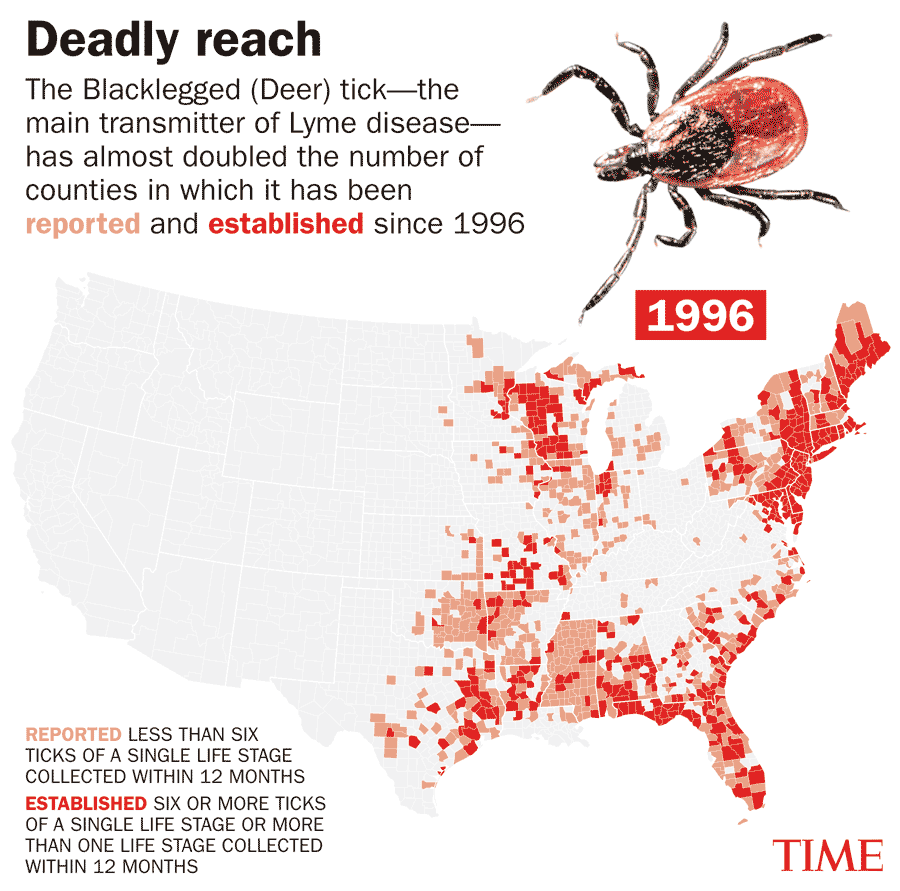
Marci Silbert wasn’t walking far on the evening of May 6. She, her husband, and another couple were visiting friends for dinner, and after eating, took a brief stroll down a short path to a small pond on their hosts’ property in the Berkshires in Massachusetts. They lingered for just a few moments, and then walked back. But that was all it took.
The next day, her husband noticed a tick embedded in his forearm. Silbert had one on the inside of her knee, and the husband in the other couple had one on his thigh. Out of an abundance of caution, they went to the hospital, had them removed, and were given prophylactic prescriptions for doxycycline to prevent Lyme disease.
“I have a dog and I had been walking her in the woods for 12 years, and I’ve never gotten a tick,” says Silbert. “And then three of us got one on that same excursion. The spring seasons have been really, really bad in the past few years.”
Time was, it wasn’t so hard to avoid ticks. They had a season (April to September), a range (parts of certain states where the temperature and precipitation conditions were just right to support them), and a predictable roster of species (like the deer tick and dog tick in the Northeast, and the Gulf Coast tick near the Gulf of Mexico).
But ticks have lately busted down the door. Go for a walk in the woods—or even your backyard—and you may come home covered in them. Send your dog for a run and she might come back crawling with ticks. If it seems like tick seasons are getting longer and worse, that’s because they are. And if it seems like 2023 is the worst—or nearly the worst—in memory, that’s because it is.
More from TIME
“From 2020 to this year, I would say it’s a 100% increase in the number of ticks humans have encountered,” says Saravanan Thangamani, professor in the department of microbiology and immunology at SUNY Upstate Medical University who tracks ticks and tick-borne diseases across New York. Until recently, Thangamani invited people from across the state to send in ticks they had encountered for identification and counting, but the sheer number of submissions and the lack of operational funds to keep up with them forced him to shut down the program.

“This is the second worst year in recent history,” says Goudarz Moulaei, a clinical professor at Yale University’s School of Public Health who also heads the department of entomology at the agricultural experiment station in Connecticut, where local residents send ticks that have bitten them, for identification and counting. “In 2023, we’ve received 1,800 ticks so far. In 2017”—which he believes was the recent apex for ticks—”we received 2,100.”
If that doesn’t seem like much in a state with a population of 3.6 million, it’s merely because only the most highly motivated tick-bite victims—who also know that the agricultural experiment station exists—send in their ticks. Countless more go unreported.
“We are seeing changes in the frequency and dynamics of tick and tick-borne disease activity throughout the northeastern U.S., down to New Jersey and Pennsylvania as well,” says Moulaei. “We’re also seeing it in the upper Midwest, in states like Wisconsin and Minnesota.” Michigan is a growing tick zone too.
So what’s responsible for the tick boom—and what can we do to keep ourselves safe?
Climate is everything
As with so much else, climate change is playing a big role in extending ticks’ breeding and biting seasons. Brief, mild winters and long, hot springs and summers are incubators for ticks, especially in the Northeast and the Midwest, which once featured punishingly cold winters, but increasingly do not.
“I can tell from the trend that we observed in January and February of this year, compared to the prior years, that we saw a large number of human-tick encounters,” says Thangamani. “That can be attributed to a very warm winter season. Anytime the temperatures are above freezing, the ticks will be out there.”
Rising temperatures affect not only the presence of ticks native to a given area, but the migration of new ones. “We’re starting to see southern species of ticks coming north,” says Dina Fonseca, professor and chair of the department of entomology at Rutgers University. “The Gulf Coast tick is now established in New Jersey. Staten Island [New York] has had the Gulf Coast tick for three or four years already, maybe five. It wouldn’t be here if it wasn’t for the fact that it’s warmer.”
In some cases, climate change actually reduces the population of ticks. Fonseca points out that the southwest is getting increasingly dry as climate change-related droughts persist, and that tends to kill off tick populations. The same is true for the plains and the western range. But elsewhere, a warming climate is a boon to ticks.
The black-legged tick—also called the deer tick, which carries Lyme disease, “used to be in the Northeast and now it has moved all the way to Eastern Canada,” says Moulaei.
A warming climate also influences the growth of vegetation, with warmer, wetter seasons meaning more leafy ground cover. That, in turn, means more white-tailed deer, mice, and other host animals to which ticks attach themselves for a blood meal—and transportation.
Human habitats and development
It’s not just going for a ramble in the woods that exposes us to ticks. How and where we choose to build homes and other structures matters too. As housing developments continue to sprawl across the U.S., we’re increasingly encroaching on the habitats of tick-carrying animals. Deer, once seen only in the wild, regularly turn up on lawns and in gardens, having lost much of their fear of humans and seeing the carefully tended vegetation as a handy place to snack.
“The white-tailed deer are what I would call the keystone host for the replication of these ticks,” says Thomas Mather, professor of public health at the University of Rhode Island and director of the school’s Tick Encounter Resource Center. “Deer are in more places than ever before.”
Homes aren’t all we build in once wild spaces. Parking lots, retail centers, and roads also cover the landscape. This has whittled away green spaces into lots and plots, and that has reduced the number of predators that once would have killed many of the small and large animals that carry ticks to human populations. A tick-carrying deer that crosses a road in, say Pennsylvania, might once have been taken out of circulation by a coyote, bear, or bobcat that are wild in the state.
“We have created fragmentation of habitat,” says Moulaei. “And these are contributing to a greater abundance of ticks.”
Stowaway ticks
Ticks don’t recognize borders, and they will cross readily from state to state and country to country—sometimes with our help. There are two principal ticks that infest cattle: the Rhipicephalus annulatus and the Rhipicephalus microplus, from Africa and Asia respectively. They transmit protozoa parasites that cause cattle fever, and get to the U.S. mostly thanks to imperfect inspection of the animals when they’re imported from the two continents.
Better inspection takes place at the U.S.-Mexico border, says Fanseca. “That inspection has been going on for a long, long time, and a lot of money has been put into it,” she says. Still, cows are big and ticks are small, and there are only so many that can be spotted when whole herds of livestock are imported at a time.
Much looser inspection—indeed, little at all—takes place when it comes to screening dogs brought in from other countries. The brown dog tick and the American dog tick, which are already common throughout the U.S., feed on both dogs and humans, spreading Rocky Mountain spotted fever, which can lead to symptoms including fever, headache, rash, and nausea, but in extreme cases can also lead to chronic, persistent infection that can in turn lead to hearing loss, amputation, and paralysis. The range of the dog tick is spreading, and the importation of dogs carrying the ticks is not helping matters any.
“Nobody’s minding the store,” says Franseca. “Dogs can just arrive, often with people on planes—and also even larger groups of dogs [like those imported by kennels] just sort of fall through the cracks.” That’s because the U.S. Centers for Disease Control and Prevention (CDC) is responsible for clearing dogs for importation, and the main hurdle the CDC makes the dogs clear is that they must have been vaccinated for rabies. Tick inspections are not conducted. “There is nothing regarding ectoparasites [like ticks],” Fonseca says.
How to protect yourself
The Northeast and Midwest are hot spots for ticks, but the pests are found all over the country, in different numbers and concentrations. The CDC provides county-by-county maps of the range of four common ticks—the American dog tick, the black-legged (or deer) tick, the western black-legged tick and the lone star tick—and as the maps make clear, few parts of the U.S. except the western plains and portions of the southwest are relatively tick-free. The CDC also lists the 16 most common diseases ticks can transmit to humans, including Lyme disease, Rocky Mountain spotted fever, babesiosis, and tularemia.
As for what you can do to protect yourself from any tick bites, the advice remains the same: If you live near an area that has ticks or you venture into forested or grassy parts, tuck your pants into your socks, use insect repellent on yourself and your clothes, do a complete tick check of yourself and your pets when you get home, shower shortly after you conduct your check, and run your clothes through the washer and especially the dryer on high heat, because hot temperatures can kill ticks.
“When you’re hiking,” says Thangamani, “it’s best to stay in the middle of the trail, rather than at the edge, where the ticks are waiting to latch onto a human.” In a year like 2023, when the tick scourge is at or near its worst, every little bit of advice can help spare you—and your pets—from suffering and disease.
More Must-Reads from TIME
- Introducing the 2024 TIME100 Next
- The Reinvention of J.D. Vance
- How to Survive Election Season Without Losing Your Mind
- Welcome to the Golden Age of Scams
- Did the Pandemic Break Our Brains?
- The Many Lives of Jack Antonoff
- 33 True Crime Documentaries That Shaped the Genre
- Why Gut Health Issues Are More Common in Women
Write to Jeffrey Kluger at jeffrey.kluger@time.com